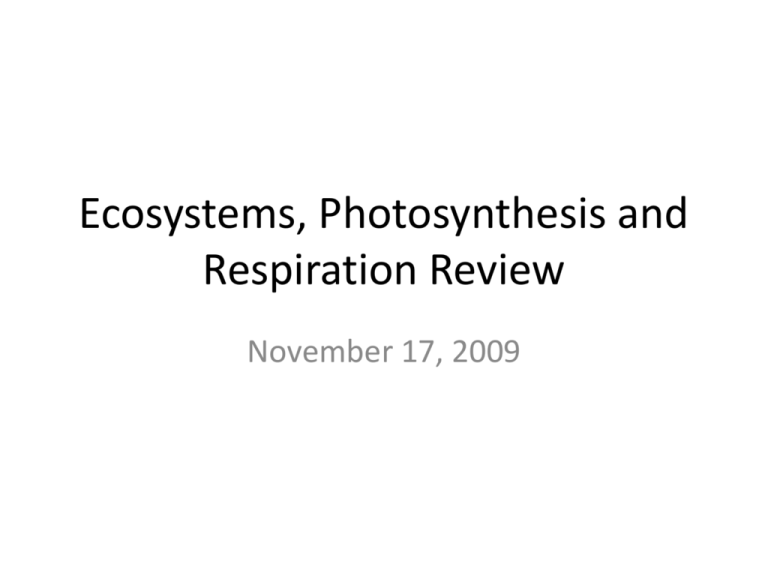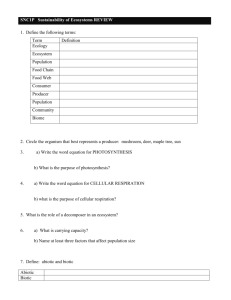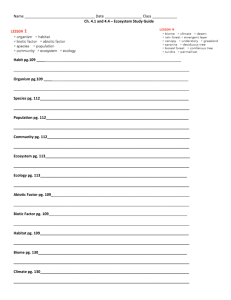Ecosystems, Photosynthesis and Respiration Review
advertisement

Ecosystems, Photosynthesis and Respiration Review November 17, 2009 A ___________ is a group of different species that live together in one area. A. B. C. D. E. Community Population Organism Ecosystem Biome 71% 29% 0% A. B. C. 0% 0% D. E. O2 represents A. B. C. D. E. Glucose Energy Carbon dioxide Water Oxygen 79% 14% 7% 0% A. 0% B. C. D. E. _________ is the process by which an organism forms carbohydrates using chemicals, rather than light, as an 100% energy source. A. Chemosynthesis B. Photosynthesis C. Cellular Respiration 0% A. B. 0% C. An ___________ includes all of the organisms as well as climate, soil, water, rocks, and other nonliving things in a given area. 100% A. B. C. D. E. Community Population Organism Ecosystem Biome 0% A. 0% 0% B. C. 0% D. E. Beavers, Grizzly Bears, and Sea Otters are all examples of? A. B. C. D. Abiotic Factors Biodiversity Keystone Species Biotic Factors 93% 7% 0% A. 0% B. C. D. The act of carefully watching something over time is known as ____. A. B. C. D. Observation Computer Models Enlightenment Experiment 92% 8% 0% A. B. 0% C. D. A ________ is a group of the same species that lives in one area. A. B. C. D. E. Community Population Organism Ecosystem Biome 93% 7% 0% A. B. C. 0% 0% D. E. Living things in an ecosystem are known as _________. A. B. C. D. Abiotic Factors Biodiversity Keystone Species Biotic Factors 71% 29% 0% A. B. 0% C. D. Organisms that get their energy from nonliving resources or that they make their own food are called: A. B. C. D. Consumers Autotrophs Producers Heterotrophs 36% A. 21% 21% B. C. 21% D. When scientists are able to describe and model nature without the natural setting, they are using? 57% A. B. C. D. Observation Computer Models Enlightenment Experiment 21% 21% 0% A. B. C. D. A _________ is a major regional or global community of organisms. A. B. C. D. E. Community Population Organism Ecosystem Biome 100% 0% A. 0% 0% B. C. 0% D. E. In the equations, the reactants of cellular respiration are the _____ of photosynthesis. 69% A. Reactants B. Products 31% A. B. H2O represents A. B. C. D. E. Glucose Energy Carbon dioxide Water Oxygen 79% 7% 7% 7% 0% A. B. C. D. E. Nonliving things in an ecosystem are known as _________. A. B. C. D. Abiotic Factors Biodiversity Keystone Species Biotic Factors 93% 7% 0% A. B. C. 0% D. A __________ is an individual living thing. A. B. C. D. E. Community Population Organism Ecosystem Biome 100% 0% A. 0% B. C. 0% 0% D. E. C6H12O6 represents A. B. C. D. E. Glucose Energy Carbon dioxide Water Oxygen 64% 14% 7% A. B. C. 7% 7% D. E. ______ is a two stage process that animals use to produce carbon dioxide and water. 50% 50% A. Chemosynthesis B. Photosynthesis C. Cellular Respiration 0% A. B. C. CO2 represents A. B. C. D. E. Glucose Energy Carbon dioxide Water Oxygen 93% 7% 0% A. 0% B. 0% C. D. E. When scientists work in natural & unnatural settings they performing a(n) A. Observation 77% B. Computer Models C. Enlightenment D. Experiment 15% 8% 0% A. B. C. D. A Rain Forest has a high level of? A. B. C. D. Abiotic Factors Biodiversity Keystone Species Biotic Factors 79% 14% 7% 0% A. B. C. D. In the equations, the products of photosynthesis are the ________ of cellular respiration. A. Reactants B. Products 92% 8% A. B. Organisms that get their energy by eating other living or once-living resources, such as plants or animals 25% 25% 25% are called: A. B. C. D. 25% Consumers Autotrophs Producers Heterotrophs A. B. C. D. Photosynthesis occurs when the sun hits the ____. A. Chloroplast B. Chlorophyll C. Mitochondria 46% 46% 8% A. B. C. _________ is a two stage process that green plants, cyanobacteria, and some protists use to produce energy. 71% A. Chemosynthesis B. Photosynthesis C. Cellular Respiration 21% 7% A. B. C.



